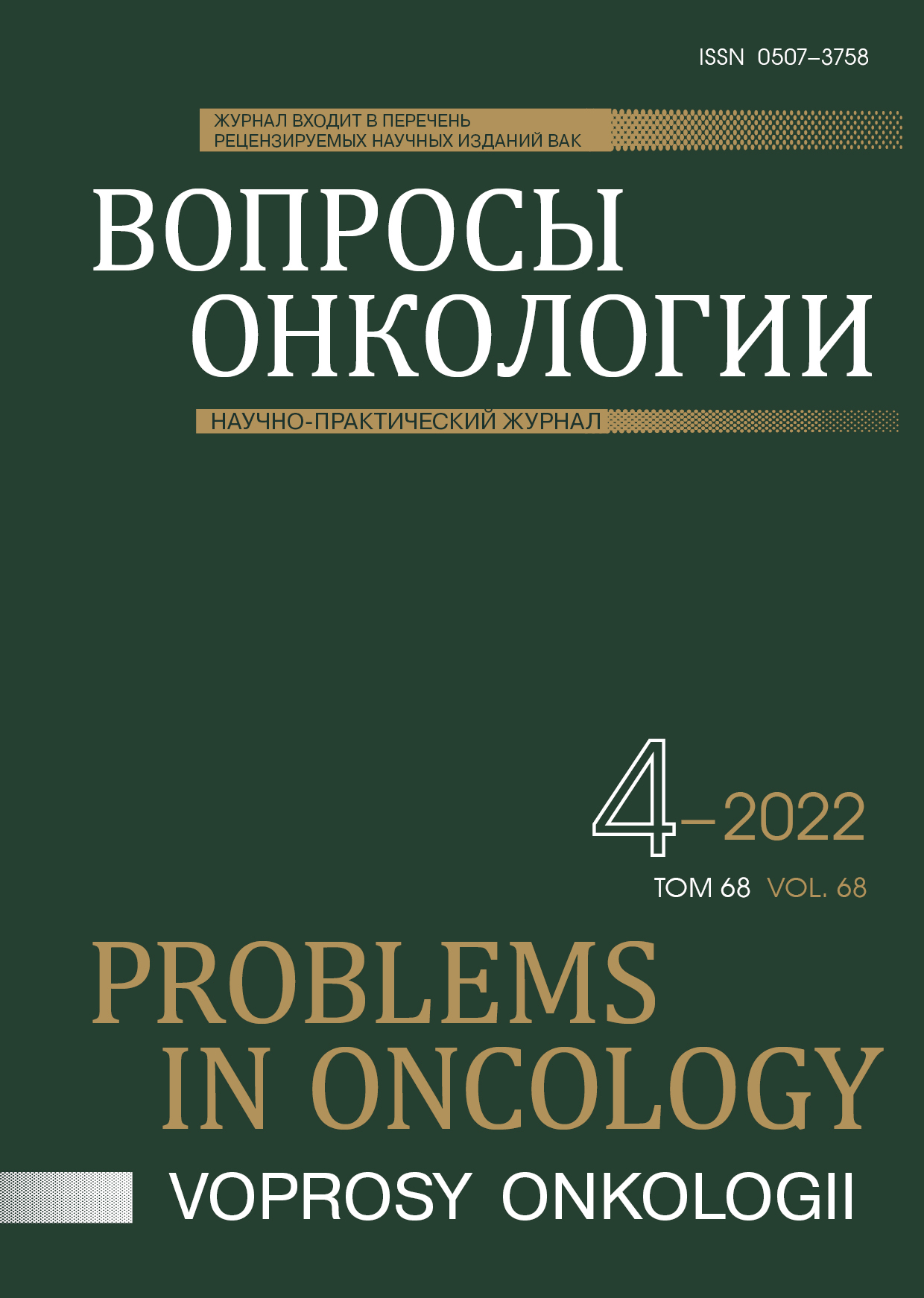Abstract
Relevance. There are no publications in the available literature on the results of treatment of patients with primary nodal non-Hodgkin's lymphomas of abdominal and pelvic localization.Purpose of research. Comparative evaluation of the effectiveness of chemoradiotherapy (CRT) and chemotherapy (CT) in the patients with primary nodal non-Hodgkin lymphomas of abdominal and pelvic localization by the criterion of the overall survival (OS).
Materials and methods. 208 patients with nodal non-Hodgkin lymphomas of abdominal and pelvic localization were retrospectively studied: 111 patients (the main group) underwent chemoradiotherapy (chemotherapy + adjuvant radiation therapy), 97 patients (the control group) received chemotherapy (CT) according to similar generally accepted schemes. The OS of the patients of the main and the control groups as a whole, as well as the subgroups with different demographic and clinical parameters were analyzed: the gender, the age, the somatic status (Karnovsky index - KI), the degree of the malignancy of lymphoma, the localization of lymphoma, the stage of the disease, size of the primary focus, the prognostic groups, the immediate effect of chemotherapy (complete remission, partial remission, stabilization). The patients with refractory disease were not included in the study.
Results. In general, for the compared groups, 10-year OS rates were statistically significantly higher in the CRT group (51.7% vs 27.5%, P=0.002), including: in the men (59.0% vs 28.7%, P=0.005), in the patients 60 years and older (51.3% vs 26.5%, P=0.011), with KI 90-80 (65.4% vs 27.2%, P=0.015), KI 70-60 (49.1% vs 27.5%, P= 0.037), at the stages I-II (85.0% vs 57.0%, P=0.044), III-IV stages (47.8% vs 19.5%, P=0.013), the tumor size of 10 cm or more (49.5% vs 22.0%, p=0.006), as well as in the patients with indolent lymphomas (55.4% vs 21.0%, P=0.01), with primary lesion of abdominal lymph nodes (47,0% vs 27,8%, p=0,042), the high-risk patients (61.7% vs 18.0%, P=0.009), the patients with the partial remission/stabilization after CT (51.3% vs 11.6%, P=0.0000..). In the patients with alternative values of the analyzed parameters, the increase in OS in the CRT group was close to significant (P=0.07-0.13). In the patients treated with Rituximab, 10-year OS was also statistically significantly higher in the CRT group (78.9% vs 26.3%, P=0.0003). Only in the patients with chemotherapy-induced complete remission and in the patients with B-cell lymphomas treated without Rituximab, the 10-year OS did not differ significantly in the main and control groups (75.2% vs 56.1%, P=0.569 and 41,8% vs 28,8%, Р=0,196). In the multivariate regression analysis, the treatment program turned out to be the most significant parameter affecting the OS (P=0.0007).
Conclusion. Compared with chemotherapy, the chemoradiotherapy program statistically significantly or at a close to significant level increases the overall survival of the most patients with nodal non-Hodgkin's lymphomas of abdominal and pelvic localization, with the exception of a cohort of patients with the complete remission achieved after frontline chemotherapy and the patients with B-cell lymphomas who did not receive Rituximab. The maximal values of OS were achieved with a combination of the frontline chemotherapy with Rituximab and the adjuvant radiation therapy.
References
Imber BS, Yahalom J. Radiotherapy for Non-Hodgkin Lymphomas. The Cancer Journal. 2020;26(3):217-30. doi: 10.1097/PPO.0000000000000453
Zimmermann M, Oeler C, Mey U, Gadjar P, Zwahlen DR. Radiotherapy for Non-Hodgkin’s lymphoma: still standard practice and not an outdated treatment option. Radiation Oncology. 2016;11(1):110. doi:10.1186/s13014-016-0690-y
Виноградова Ю.Н., Ильин Н.В. Лучевая терапия в комбинированном лечении неходжкинских лимфом. Злокачественные опухоли. 2015;4(2):44–48. [Vinogradova YuN, Ilyin NV. Radiation therapy in the combined treatment of non-Hodgkin's lymphomas. Malignant tumors. 2015;4(2):44–48 (In Russ.).] doi: 10.18027/2224-5057-2015-4s2-44-48
Dabaja BS, Ng AK, Terezakis SA, Plastaras JP, Yunts M, Wilson LD et al. Making every single gray count: involved site radiation therapy delineation guidelines for hematological malignancies. Int J Radiation Oncol Biol Phys. 2020;106(2):279-81. doi:10.1016/j.ijrobp.2019.10.029
Тумян Г.С., Заводнова И.З., Кичигина М.Ю., Медведовская Е.Г. Первичная медиастинальная (тимическая) В-крупноклеточная лимфома. Клиническая онкогематология. 2017;10(1):13–24. [Tumyan GS, Zavodnova IZ, Kichigina MYu, Medvedovskaya EG. Primary Mediastinal (Thymic) Large B-Cell Lymphoma. Clinical oncogematology. 2017;10(1):13–24. (In Russ.)] doi: 10.21320/2500-2139-2017-10-1-13-24
Виноградова Ю.Н., Ильин Н.В., Ларинов Д.В., Ходжибекова М.М., Костеников Н. А. Лучевая терапия в комбинированном лечении диффузной B-крупноклеточной лимфомы. Клиническая онкогематология. 2013;6(4):415–420. [Vinogradova YuN, Ilin NV, Larinov DV, Khodzhibekova MM, Kostenikov NA, Korytova LI. Radiotherapy in combined treatment of patients with diffuse large B-cell lymphoma. Clinical oncogematology. 2013;6(4):415–420. (In Russ.)]
Liu XH, Liu H, Ke D, Ke XK, Wang YD. Clinical and prognostic features of primary retroperitoneal diffuse large B-cell lymphoma: a single-center experience in China. Chin Med J 2021;134:2750–2752. doi: 10.1097/CM9.0000000000001473
Cheson BD, Fisher RI, Barrington SF, Cavalli F, Schwartz LH, Zucca E et al. Recommendations for initial evaluation, staging, and response assessment of hodgkin and non-hodgkin lymphoma: the Lugano classification. Journal of Clinical Oncology. 2014;32(27):3059-3067. doi: 10.1200/jco.2013.54.8800.
Swerdlow SH, Campo E, Pileri SA, Harris NL, Stein H, Siebert R et al. The updated WHO classification of hematological malignancies. The 2016 revision of the World Health Organization classification of lymphoid neoplasms. BLOOD. 2016;127(20):2375-2390 doi:10.1182/blood-2016-01-643569.
Phan J, Mazloom A, Medeiros LJ, Zreik TG, Wogan C, Shihadeh F et al. Benefit of consolidative radiation therapy in patients with diffuse large B-cell lymphoma treated with R-CHOP chemotherapy. Journal of Clinical Oncology. 2010;28(27):4170-76. doi: 10.1200/JCO.2009.27.3441.
Zheng S, Esiashvili N, Flowers C, Das S, Khurram Khan M. Renewed interest in the role of consolidative radiotherapy in advanced stage diff use large B-cell lymphoma Leukemia & Lymphoma. 2013;54(10):2122–30. doi: 10.3109/10428194.2013.779687.

This work is licensed under a Creative Commons Attribution-NonCommercial-NoDerivatives 4.0 International License.
© АННМО «Вопросы онкологии», Copyright (c) 2022
